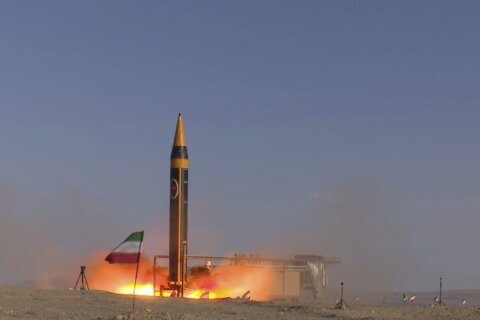WASHINGTON — A plot to attack the Cathedral of Notre Dame in Paris unraveled earlier this month after a police officer spooked a female attacker. She fled, leaving a car loaded with gas canisters sitting very close to the iconic structure with its hazard lights flashing. She never had the chance to detonate them.
French authorities eventually arrested three women on terrorism charges. They are part of what authorities fear may be a wave of women fighters partially inspired by a former female punk-rocker turned terrorist.
Sally Jones, the British widow of a prominent Islamic State of Iraq and the Levant (ISIL) leader, who released location information about U.S. military members in 2015, has re-emerged in Raqqa, Syria.
This time, she’s not just taunting the U.S. intelligence community — she’s allegedly building an army of women fighters for ISIL.
“There were some recent reports out that she is leading a cell targeting women specifically in terms of recruitment and in terms of carrying out attacks particularly in the West,” said Tara Maller, senior policy adviser at the Counter Extremism Project (CEP).
According to an account from an “ISIL defector” in London’s Telegraph newspaper, Jones is now head of “the secretive female wing the Anwar al-Awlaki battalion.” The unit was formed by her late husband, Junaid Hussain, ISIL’s social media architect, who was killed in August 2015 in a U.S. precision strike.
ISIL is trying to leverage the unique advantage of using women in attacks, Maller said. According to CEP, Jones issued terrorist threats against the United Kingdom, calling upon Muslim women to launch terrorist attacks in London, Glasgow and Wales during Ramadan.
To Maller, the use of female attackers is a distinction without a difference.
“A suicide bomb is a suicide bomb, so the danger and the risk is the same — man or woman. But the reason why there is a strategic difference is because traditionally more terrorists have been men, and it is sometimes easier for women to fly under the radar,” Maller said.
Female members of terror organizations are not a new phenomenon. A female suicide bomber killed India’s former leader Rajiv Ghandi in 1991.
But today’s female terrorists are quietly growing into a force that counterterrorism authorities all over Europe and the U.S. are coming to grips with.
“ISIL is opportunistic and has shown that it is only too happy to exploit whatever resources and recruits it is able to marshal,” a U.S. intelligence official told WTOP.
FBI Director Jim Comey warned Congress in late 2015 that ISIL had learned how to appeal to more than just angry young men.
“Unlike other groups, ISIL has constructed a narrative that touches on all facets of life — from career opportunities to family life to a sense of community. The message isn’t tailored solely to those who are overtly expressing symptoms of radicalization,” said Comey.
He indicated many, including women, who join the group are attracted by its online messaging.
“It is seen by many who click through the internet every day, receive social media push notifications, and participate in social networks,” said Comey. “Ultimately, many of these individuals are seeking a sense of belonging.”
In June, Spanish authorities arrested four suspects linked to three terrorist cells in Cueta — a 7-square-mile, autonomous Spanish city on the north coast of Africa, next to Morocco.
Two of the cells were headed by men. One cell, according to a Spanish magistrate, recruited adolescent girls with family problems, illnesses and mental handicaps. Two men from a second cell recruited women from former romantic relationships.
A third cell was run by a woman. She used the social media applications Facebook, WhatsApp and Telegram to recruit girls. The objective of that cell, according to a foreign intelligence source close to the case, “was to send young women to Iraq and Syria to marry ISIL fighters and give birth to a new generation of terrorists.”
“Official data confirm that there are DA’ESH (ISIL) camps in which women are preparing to carry out terrorist attacks in Europe and the U.S., according to Europol. They are spaces for tactical training,” said Jose Maria Gil, director of the department of terrorism studies at Spain’s Institute of Global Security. “In Europe, we have already seen cases of women integrated in ISIL terrorist operations.”
He recalled an incident following the Paris terror attacks.
“On Nov. 13, 2015, when French police raided a flat in Saint Denis where the suspects were holed up, a woman acted against the policemen by triggering a suicide-bomb belt,” he said.
The turn toward women as fighters, according to the U.S. official, is an ironic part of the organization’s desperation to survive.
“Like in many Sunni extremist groups, ISIL men wield authority and women are at best second-class citizens [and] are often treated much worse,” the official said.
The U.S. military has noted the same irony.
“It is an organization that is so completely demeaning to women, that degrades them, forces them into marriages and sexual slavery, and at the same time it has women in it that serve in positions of prominence and leadership as well,” said Navy Capt. Jeff Davis, a spokesman for the Pentagon.
But Davis said there will be no difference in the way female attackers are treated.
“We’ll absolutely take action to protect ourselves, to engage the enemy and remove people from the battlefield, regardless of gender,” he said.
Security organizations charged with advising their U.S. clients are faced with a difficult task.
“Given our propensity to always be ‘fighting the last battle,’ unless and until female terrorists become more commonplace, many security officers in the West may not appreciate this threat until it is too late,” said Mike Maness, director of global threat detection firm Trapwire and a former CIA officer who conducted covert operations against terrorists for 20 years.
“Most of us probably view a woman pushing a baby stroller as one of the least threatening people you’ll encounter,” Maness said. “However, this ‘cover for action’ could be used to launch devastating attacks against soft targets around the country.”








